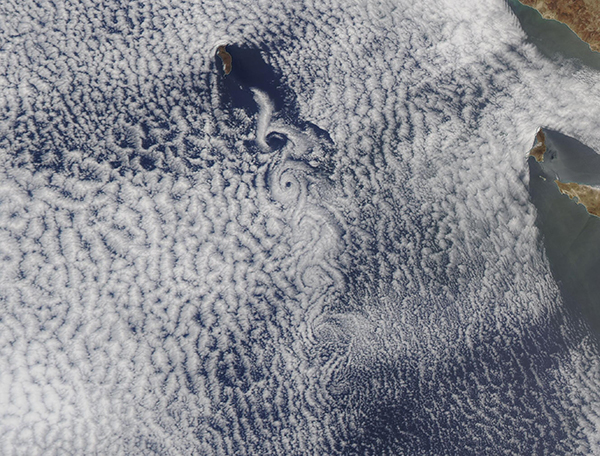Images
May 19, 2022 - Von Kármán Vortices in the Clouds off Guadalupe Island
Tweet
On May 17, 2022, the Moderate Resolution Imaging Spectroradiometer (MODIS) on board NASA’s Aqua satellite acquired a true-color image of stunningly beautiful swirls in a large bank of marine stratocumulus clouds near Guadalupe Island. The string of alternate swirls, which form string of paisley-like patterns on the lee side of Guadalupe Island are called “von Kármán vortices” and arise when winds are diverted around a blunt, high-profile object, often an island rising from the ocean. The alternating direction of rotation in the air forms swirls in the clouds. Such vortices were first described in 1912 by physicist Theodore von Kármán.
Guadalupe Island sits in the Pacific Ocean about 150 miles off of the coast of Mexico’s Baja California. Only 21 miles (35 km) long, the highest point, Mount Augusta, soars to 4,257 feet (1,297 meters—creating a significant impediment to the movement of wind blowing by it over an otherwise nearly-flat ocean surface. When rushing water slams into an immobile object—such as a dock piling—it’s easy to see that turbulence is created, leaving swirls behind the piling. Principals of fluid motion also apply to the atmosphere, so when winds are diverted around an immobile object, such as a tall mountain on an island, turbulence is created on the lee side (the side away from the motion of the wind). Since air is invisible, this atmospheric ocean is only visible when clouds fill the sky.
Image Facts
Satellite:
Aqua
Date Acquired: 5/17/2022
Resolutions:
1km (410.1 KB), 500m (1019.5 KB), 250m (718.7 KB)
Bands Used: 1,4,3
Image Credit:
MODIS Land Rapid Response Team, NASA GSFC
Tweet
On May 17, 2022, the Moderate Resolution Imaging Spectroradiometer (MODIS) on board NASA’s Aqua satellite acquired a true-color image of stunningly beautiful swirls in a large bank of marine stratocumulus clouds near Guadalupe Island. The string of alternate swirls, which form string of paisley-like patterns on the lee side of Guadalupe Island are called “von Kármán vortices” and arise when winds are diverted around a blunt, high-profile object, often an island rising from the ocean. The alternating direction of rotation in the air forms swirls in the clouds. Such vortices were first described in 1912 by physicist Theodore von Kármán.
Guadalupe Island sits in the Pacific Ocean about 150 miles off of the coast of Mexico’s Baja California. Only 21 miles (35 km) long, the highest point, Mount Augusta, soars to 4,257 feet (1,297 meters—creating a significant impediment to the movement of wind blowing by it over an otherwise nearly-flat ocean surface. When rushing water slams into an immobile object—such as a dock piling—it’s easy to see that turbulence is created, leaving swirls behind the piling. Principals of fluid motion also apply to the atmosphere, so when winds are diverted around an immobile object, such as a tall mountain on an island, turbulence is created on the lee side (the side away from the motion of the wind). Since air is invisible, this atmospheric ocean is only visible when clouds fill the sky.
Image Facts
Satellite:
Aqua
Date Acquired: 5/17/2022
Resolutions:
1km (410.1 KB), 500m (1019.5 KB), 250m (718.7 KB)
Bands Used: 1,4,3
Image Credit:
MODIS Land Rapid Response Team, NASA GSFC




